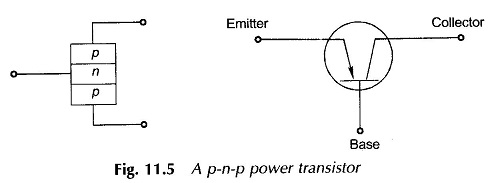What is Power Transistor? | Definition | Working | Applications:
What is Power Transistor? – Power Transistors are now available in ratings suitable for motor control. This device is a 3-layer p-n-p (or n-p-n) structure, as shown in Fig. 11.5. This type of transistor is known as a bipolar junction transistor (BJT).
Working:
In normal operation the emitter-base junction is forward-biased and the collector-base junction reverse-biased. The collector current is almost equal but slightly less than the emitter current. The collector current can be controlled by the base current. Except for small motors, transistors are employed in the switching (on/off) mode. The common-emitter configuration is normally used owing to its higher power gain. The common-emitter saturation voltage VCE (SAT) for typical Power Transistor is from 0.3 to 0.7 V. This being sufficiently less than the on-state anode-to-cathode voltage drop of an SCR, the average power-loss in a transistor is less than that of an SCR of an equivalent power rating.  The switching of a Power Transistor is controlled through the base current. A continuous base current is required to keep the transistor in the saturated state, i.e the on-state. In a high-current device, the base-to-collector current gain is as low as 10, and therefore a base current of several amperes is required to keep the device in the on-state; the power-loss in the base circuit may be appreciable. The rise time in turn-on may be reduced by momentarily overdriving the base current. To initiate turn-off, the excess saturation charge, which is proportional to the base current, must be removed from the base region before the transistor can begin to return to the off-state. This storage delay time can be minimized by applying reverse current to the base during turn-off.
The switching of a Power Transistor is controlled through the base current. A continuous base current is required to keep the transistor in the saturated state, i.e the on-state. In a high-current device, the base-to-collector current gain is as low as 10, and therefore a base current of several amperes is required to keep the device in the on-state; the power-loss in the base circuit may be appreciable. The rise time in turn-on may be reduced by momentarily overdriving the base current. To initiate turn-off, the excess saturation charge, which is proportional to the base current, must be removed from the base region before the transistor can begin to return to the off-state. This storage delay time can be minimized by applying reverse current to the base during turn-off.
Power Transistors have no surge current capacity and can withstand only a low rate of change of current. There is no regenerative action in a transistor and it needs a continuous base current to continue in the on-state, whereas an SCR requires only a gate pulse to turn it on. The switching times of power transistors are, however, generally faster than those of SCRs, and the commutation problems of SCR are not present in transistors. Power Transistors are finding increasing popularity in low-to medium-power applications, where they compete successfully with thyristors and GTOs. The transistor can switch considerably faster than the thyristor, typically a switching time of less than 1 μs being possible.
Applications:
Power Transistor applications range from a few kW to several hundred kWs size in voltage-fed choppers and inverters with switching frequency up to 10-15 kHz. The state of the art devices are available with ratings up to 600 V, 500A.